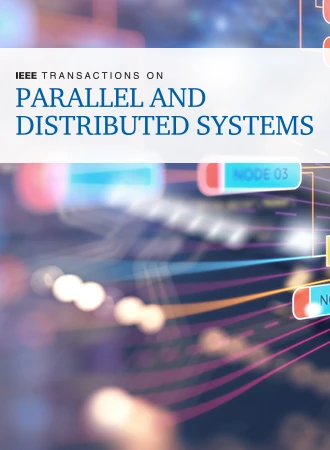FastTuning: Enabling Fast and Efficient Hyper-Parameter Tuning With Partitioning and Parallelism of Search Space
IF 5.6
2区 计算机科学
Q1 COMPUTER SCIENCE, THEORY & METHODS
IEEE Transactions on Parallel and Distributed Systems
Pub Date : 2024-04-10
DOI:10.1109/TPDS.2024.3386939
引用次数: 0
Abstract
Hyper-parameter tuning (HPT) for deep learning (DL) models is prohibitively expensive. Sequential model-based optimization (SMBO) emerges as the state-of-the-art (SOTA) approach to automatically optimize HPT performance due to its heuristic advantages. Unfortunately, focusing on algorithm optimization rather than a large-scale parallel HPT system, existing SMBO-based approaches still cannot effectively remove their strong sequential nature, posing two performance problems: (1) extremely low tuning speed and (2) sub-optimal model quality . In this paper, we propose FastTuning, a fast, scalable, and generic system aiming at parallelly accelerating SMBO-based HPT for large DL/ML models. The key is to partition the highly complex search space into multiple smaller sub-spaces, each of which is assigned to and optimized by a different tuning worker in parallel. However, determining the right level of resource allocation to strike a balance between quality and cost remains a challenge. To address this, we further propose NIMBLE, a dynamic scheduling strategy that is specially designed for FastTuning, including (1) Dynamic Elimination Algorithm, (2) Sub-space Re-division, and (3) Posterior Information Sharing. Finally, we incorporate 6 SOTAs (i.e., 3 tuning algorithms and 3 parallel tuning tools) into FastTuning. Experimental results, on ResNet18, VGG19, ResNet50, and ResNet152, show that FastTuning can consistently offer much faster tuning speed (up toFastTuning:利用搜索空间的分割和并行性实现快速高效的超参数调整
深度学习(DL)模型的超参数调整(HPT)成本过高。基于序列模型的优化(SMBO)因其启发式优势而成为自动优化 HPT 性能的最先进(SOTA)方法。遗憾的是,现有的基于 SMBO 的方法侧重于算法优化而非大规模并行 HPT 系统,仍无法有效消除其强烈的顺序性,从而带来两个性能问题:(1) 极低的调整速度和 (2) 次优模型质量。本文提出的 FastTuning 是一种快速、可扩展的通用系统,旨在并行加速基于 SMBO 的大型 DL/ML 模型的 HPT。其关键在于将高度复杂的搜索空间划分为多个较小的子空间,每个子空间分配给不同的调优人员并由其并行优化。然而,如何确定正确的资源分配水平,在质量和成本之间取得平衡仍然是一个挑战。为了解决这个问题,我们进一步提出了 NIMBLE,一种专为 FastTuning 设计的动态调度策略,包括:(1)动态消除算法;(2)子空间再划分;(3)后验信息共享。最后,我们在 FastTuning 中加入了 6 个 SOTAs(即 3 个调优算法和 3 个并行调优工具)。在ResNet18、VGG19、ResNet50和ResNet152上的实验结果表明,FastTuning可以持续提供更快的调谐速度(高达80美元/次)和更高的精度(高达4.7%的改进),从而使自动HPT应用于现实生活中的DL模型。
本文章由计算机程序翻译,如有差异,请以英文原文为准。
求助全文
约1分钟内获得全文
求助全文
来源期刊

IEEE Transactions on Parallel and Distributed Systems
工程技术-工程:电子与电气
CiteScore
11.00
自引率
9.40%
发文量
281
审稿时长
5.6 months
期刊介绍:
IEEE Transactions on Parallel and Distributed Systems (TPDS) is published monthly. It publishes a range of papers, comments on previously published papers, and survey articles that deal with the parallel and distributed systems research areas of current importance to our readers. Particular areas of interest include, but are not limited to:
a) Parallel and distributed algorithms, focusing on topics such as: models of computation; numerical, combinatorial, and data-intensive parallel algorithms, scalability of algorithms and data structures for parallel and distributed systems, communication and synchronization protocols, network algorithms, scheduling, and load balancing.
b) Applications of parallel and distributed computing, including computational and data-enabled science and engineering, big data applications, parallel crowd sourcing, large-scale social network analysis, management of big data, cloud and grid computing, scientific and biomedical applications, mobile computing, and cyber-physical systems.
c) Parallel and distributed architectures, including architectures for instruction-level and thread-level parallelism; design, analysis, implementation, fault resilience and performance measurements of multiple-processor systems; multicore processors, heterogeneous many-core systems; petascale and exascale systems designs; novel big data architectures; special purpose architectures, including graphics processors, signal processors, network processors, media accelerators, and other special purpose processors and accelerators; impact of technology on architecture; network and interconnect architectures; parallel I/O and storage systems; architecture of the memory hierarchy; power-efficient and green computing architectures; dependable architectures; and performance modeling and evaluation.
d) Parallel and distributed software, including parallel and multicore programming languages and compilers, runtime systems, operating systems, Internet computing and web services, resource management including green computing, middleware for grids, clouds, and data centers, libraries, performance modeling and evaluation, parallel programming paradigms, and programming environments and tools.
 求助内容:
求助内容: 应助结果提醒方式:
应助结果提醒方式:


